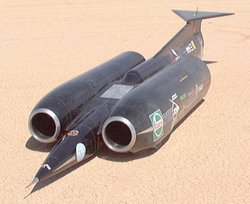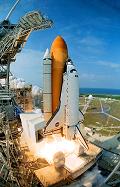Sound has a huge impact on our day to day lives. Just think of how much of our technology involves sending or receiving sounds in various forms.
- Most people don’t fully understand what sound is.
- In this section we will be looking at the basic properties of sound.
Sound is a longitudinal wave.
- Remember that longitudinal waves are made up of areas where the wave is compressed together, and other areas where it is expanded.
- This would agree with the way that humans themselves make sounds. We force air, sometimes harder, sometimes softer, through our vocal cords.
- In the process the air is either squished or allowed to move freely… making the air into a longitudinal wave!
We will look in detail at three fundamental characteristics of sound: speed, frequency, and loudness.
Speed
The speed of sound in air actually depends on the temperature of the air.
- As a standard, we will say that the speed of sound is 340m/s at 15°C. If you are not told anything different in a question, use this value.
- If you did need to calculate the speed of sound at a different temperature, you could use this formula as a rough estimate (you are not required to memorize this formula)…
v = 331.5m/s + 0.6T
v = velocity of sound (m/s)
T = temperature (°C)

On October 15, 1997 the British built "Thrust SSC" vehicle became the first land based vehicle to break the sound barrier. To be official it had to break the sound barrier twice within one hour. It did this, with an average top speed on the two runs of Mach 1.020. The runs took place in early in the day so that the temperature of the air (and the speed of sound) would be lower. As an interesting side note, this record was set one day after the 50th anniversary of the first supersonic flight made by Chuck Yeager on October 14, 1947 in the "Bell X-1."
Example 1: Determine the speed of sound when it is –5°C.
v = 331.5m/s + 0.6(-5)
v = 331.5m/s + -3m/s
v = 328.5 m/s

You can observe an example of how the speed of sound affects when you hear it compared to the occurrence of the event that caused the sound.
- During a thunderstorm, watch for a lightning strike. You see it first because light travels at a very high speed (3.00e8m/s), which is so fast it travels to your eye from the lightening almost instantly.
- Now listen for the thunder. The sound is traveling at a sluggish (compared to light!) 340m/s behind the flash of light.
- For every 3 seconds that you count between the flash and the sound there is a distance of about one kilometre between you and the lightning.
Sound can also travel through solids and liquids, not just gases.
- This is why you can still hear stuff, even if it’s distorted, when you are under water at a swimming pool.
- The speed of sound in liquids is quicker than in gases, and the speed of sound in solids is even quicker.
- This is because the atoms are closer together, so they transfer the sound more efficiently.
- You might have even seen people in movies listening for an approaching train by putting an ear on the train tracks and listening for it. Don’t try this! It’s very dangerous!
- The sound of the train travels faster and more efficiently through the solid train tracks.
Frequency
If you are doing calculations of the wavelength or frequency of sound, you still use the standard formula…
v = f λ
- If the sound you are measuring is at a constant temperature then the velocity will be constant… about 340 m/s.
What sort of frequencies of sound will you typically be talking about?
- Most often we will be looking at sound waves that humans can actually hear, which are frequencies from 20 – 20 000 Hz.
- Check out the specifications for headphones printed on the back of the package. They’ll probably list their range from 20 – 20 000Hz, since that’s what the average person can hear.
- 20 Hz would be very deep, low, rumbling sounds.
- 20 000 Hz would be a very high pitched, squealing sort of noise. (N.B. In music “pitch” means the same as frequency.
| Name | Frequency Range (Hz) | Characteristics |
|---|---|---|
| Infrasonic | 0 - 20 | Very low frequencies of sound that the human ear can’t detect, but you may feel the rumbling of the waves through your body. |
| Sonic (AKA Audio) | 20 - 20 000 | Normal range for human ears, although not everyone (especially the elderly) will hear to the extremes of this range. |
| Ultrasonic | 20 000 + | Beyond normal hearing for humans, although some animals (like dogs) hear part ways into this range. Also used in medicine (e.g. ultrasounds for pregnant women). |
Example 2: My wife and I are listening to my favourite Bugles song, “Video Killed the Radio Star” from the 1980’s. At one point the singer hits a note that my wife thinks has a wavelength of 0.014m. I tell her this is impossible… explain why.
We will assume that the speed of sound is 340 m/s. That means that we will get…
v = f λ
f = v / λ
f= (340m/s) / (0.014m)
f = 24 286 Hz = 2.4e4 HzThis frequency is beyond the range of normal human hearing. We wouldn’t be able to hear it, and it is unlikely that our stereo system could produce a sound with a frequency that high.
If the speed of sound changed due to a change in the temperature of the air, it would make notes sound "off key."
- This is why an orchestra “warms up” before a performance.
- If a flute was tuned to the right frequency when the metal is cold, the frequency will change as the person plays for the first few minutes and the instrument heats up from their breath.
- Every instrument gets played for a few minutes to make sure that it is at a constant temperature for the whole performance and is then tuned.

Example 3: I am playing the flute (yes, I actually can, I’m just not very good!), and tuned it straight out of the case. The temperature of the flute was 17°C and I tuned it to
15 000 Hz. I start playing the flute, and by the time I’m a few minutes into the song I notice that the notes all seem wrong. If the flute has warmed up to my body temperature (37°C) , determine what my original tuned note has changed to.
First we need to calculate the speed of sound at 17°C…
v = 331.5m/s + 0.6(17)
v = 331.5m/s + 10.2m/s
v = 341.7 m/sNext we figure out the wavelength of the note I tuned. This wavelength will remain constant, even if the flute warms up.
v = f λ
λ = v/f
λ = (341.7m/s) / (15 000Hz)
λ= 0.02278 mThird, what’s the speed of sound at 37°C (body temperature)…
v = 331.5m/s + 0.6(37)
v = 331.5m/s + 22.2m/s
v = 353.7 m/sWhich means, finally, I can calculate what the frequency of the note has changed to. This is based on the constant wavelength and the new speed of sound.
v = f λ
f = v / λ
f = = (353.7m/s) / (0.02278m)
f = 15 527HzThe frequency has jumped up by more than 500Hz! This will be a very noticeable difference, even for someone that doesn’t know anything about music… the notes will just sound wrong.
Loudness
The loudness of a sound depends on the wave’s amplitude.
- This is why a stereo system has an “amplifier”, a device that increases the amplitude of sound waves.
- The louder a sound, the bigger the amplitude.
- This is also a way of measuring the amount of energy the wave has.
The system used to measure the loudness of sounds is the decibel system, given the unit dB.
- The decibel system is based on logarithms, which means for every step up by one, the sound is actually ten times louder. For example, a 15dB sound is ten times louder than a 14dB sound.
The decibel is actually a fraction of a bel, the original unit for measuring sound (1 db = 0.1 b). The "bel" was originally named after Alexander Graham Bell, the inventor of the telephone. Because the bel was too high a value for day to day situations, the decibel became a standard.
| Range (dB) | Description | Examples |
|---|---|---|
| 0 - 30 | Very Quiet | This is the threshold of human hearing, up to the sound of a quiet whisper. |
| 31 - 50 | Quiet | This is an average quiet house, with maybe the sound of a fridge running or someone moving around. |
| 51 - 70 | Normal | Regular daily sounds like people talking. |
| 71 - 90 | Loud | This is the point where a sound becomes annoying or distracting. Vacuums or a noisy car on a busy street are at these levels. |
| 91 - 110 | Very Loud | Most people will try to avoid being in areas this loud. Prolonged exposure can cause permanent ear damage. Temporary effects, like "stereo hiss", may happen. |
| 111 + | Painful!!! | Even limited exposure to levels this high will cause permanent hearing loss. |
You want to know the scary part? Most concerts you go to will have sound levels between 100 – 130 dB… easily into the permanent damage range.
- Lot’s of old rock stars have permanent hearing loss.
- Many modern day musicians wear ear protection of some sort while in concert.

One of the loudest man-made sounds is created by the space shuttle lifting off. It will generate sounds at an incredible 215 dB!!! The sound is so loud that it would actually cause damage to the launch tower, and as a reflected echo, to the shuttle itself. To absorb the energy, huge amounts of water are pumped to the base of the launch pad seconds before takeoff. The water absorbs the sound, as well as a lot of heat. When you see video of a shuttle launch, most of the white stuff you see billowing from the launch pad right at takeoff is not smoke... it's steam!